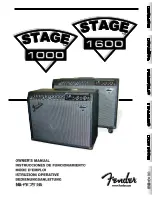
Crossover Setup for Bi-Amplified System
with one 450/4:
Once the input sections have been configured
appropriately, go to the
“CH 1&2 Filter Section”.
Select
“x1”
on the
“Freq. Range”
switch,
“LP”
(low-
pass) on the
“Filter Type”
switch and
“12dB”
or
“24dB”
on the
“Filter Mode/Slope”
switch and an
appropriate
“Filter Freq.”
(80-90 Hz is a good
starting point). You may also choose to activate the
“Infrasonic Filter”
and/or
“Bass EQ”
features in the
“CH 1&2 Bass Control”
section. Please keep in
mind that activation of the
“Bass EQ”
may require
lowering the CH 1&2
“Input Sens.”
to maintain clean
maximum output.
Next, turn your attention to the
“CH 3&4 Input
Section”
and select
“x1”
on the
“Freq. Range”
switch,
“HP”
(high-pass) on the
“Filter Type”
switch
and
“12dB”
or
“24dB”
on the
“Filter Mode/Slope”
switch and an appropriate
“Filter Freq.”
(again, 80-
90 Hz is a good starting point).
After proper adjustment of the CH 1&2 and CH
3&4
“Input Range”
and
“Input Sens.”
controls using
the method shown in Appendix B (page 20), you
can fine tune filter frequencies and slopes and
attenuate either pair of channels to achieve proper
balance. For precise filter frequency information refer
to Appendix A (page 20).
BI-AMPLIFIED SYSTEM WITH ONE 450/4 IN
FOUR-CHANNEL MODE AND A SEPARATE
SUBWOOFER AMPLIFIER
This configuration requires that the separate
subwoofer amplifier has a built-in low-pass filter. All
JL Audio subwoofer amplifiers have this feature.
In this configuration, CH 1&2 of the 450/4 will
drive front component speakers (stereo 150W x 2)
with high-pass filtering. CH 3&4 will drive rear
component speakers in stereo (75W x 2) with high-
pass filtering.
The separate amplifier will drive the subwoofer
system with low-pass filtering (select a filter
frequency of 80-90 Hz to start).The inputs of the
subwoofer amplifier may or may not be connected
to the preamp outputs of the 450/4, depending on
which connection option you choose.
Input connection options for a bi-amplifier system
with one 450/4 and a separate subwoofer amplifier
are as follows:
A) No User Adjustability
Required:
a basic source unit or processor with left
and right stereo outputs.
Input Connections:
a single pair of stereo source
unit outputs is connected to the CH 1&2 inputs of
the 450/4 (select
“2ch”
on the
“Input Mode”
switch in the
“CH 1&2 Input Section”
). Connect
the subwoofer amplifier inputs to the preamp
outputs of the 450/4 (Select
“1&2”
on the
“Signal
From”
switch in the
“Preamp Output Section”
).
Result:
the relative level of the LF and front and rear
HF channels will be fixed by the 450/4’s
“Input
Sens.”
settings and will not be user adjustable from
the front of the vehicle.
B) Fade Subwoofer Level vs. HF Level
Required:
a source unit or processor with front and
rear pairs of stereo outputs.
Input Connections:
one stereo pair of source unit
JL AUDIO
450/4
13
SYSTEM CONFIGURATIONS
The 450/4 is a very flexible amplifier, well-suited
for a multitude of system configurations. In this
section, the most likely configurations are explained
in detail.
Once you have selected your desired
configuration, you can use the amplifier panel
drawings on the bottom of the following
pages to mark the required switch positions for
easy reference.
BI-AMPLIFIED SYSTEMS
Bi-amplified systems are defined as systems in
which separate amplifier channels drive low-
frequency (LF) and high-frequency (HF) speakers and
are separately filtered to send appropriate frequency
ranges to each speaker system.
The most common application of bi-amplification
in mobile audio is to drive a subwoofer system from
one or more amplifiers or channels and component
speakers from separate amplifiers or channels.
The 450/4 can be configured to drive a bi-
amplified system by itself or with a separate
subwoofer amplifier.
BI-AMPLIFIED SYSTEM WITH ONE 450/4
In this configuration, CH 1&2 of the 450/4 will
drive subwoofers (stereo 150W x 2 or bridged
300W x 1) with low-pass filtering. CH 3&4 will drive
component speakers in stereo (75W x 2) with high-
pass filtering.
Input connection options for a bi-amplified system
with one 450/4 are as follows:
A) No User Adjustability
Required:
a basic source unit or processor with left
and right stereo outputs.
Input Connections:
a single pair of stereo source
unit outputs connected to the CH 1&2 inputs of
the 450/4 (select
“2ch”
on the
“Input Mode”
switch in the
“CH 1&2 Input Section”
).
Result:
the relative level of the LF and HF
channels will be fixed by the 450/4’s
“Input Sens.”
settings and will not be user adjustable from the
front of the vehicle.
B) Fade Subwoofer Level vs. HF Level
Required:
a source unit or processor with front and
rear pairs of outputs.
Input Connections:
the first stereo pair of source
unit outputs is connected to the CH 1&2 inputs of
the 450/4.The second stereo pair of source unit
outputs is connected to the CH 3&4 inputs (select
“4ch”
on the
“Input Mode”
switch in the
“CH 1&2
Input Section”
).
Result:
in this mode, the user has the ability to fade
or control the level of the LF channels relative to
the HF channels via the source unit’s fader control
without exceeding the maximum clean output level
set by each amplifier section’s
“Input Sens.”
controls.
C) Subwoofer Level Control Only
Required:
a source unit or processor with left, right
and subwoofer outputs.
Input Connections:
the main stereo pair of source
unit outputs is connected to the CH 3&4 inputs of
the 450/4.The source unit’s dedicated subwoofer
output is connected to the CH 1&2 inputs (select
“4ch”
on the
“Input Mode”
switch in the
“CH 1&2
Input Section”
).
Result:
in this mode, the user has the ability to
control the absolute level of the LF channels relative
to the HF channels.
Set the CH 1&2
“Input Sens.”
with the source
unit’s subwoofer level control set at 3/4 of full
output. See Appendix B (page 20) for details.
I M P O RTA N T
!
12
JL AUDIO
450/4

































